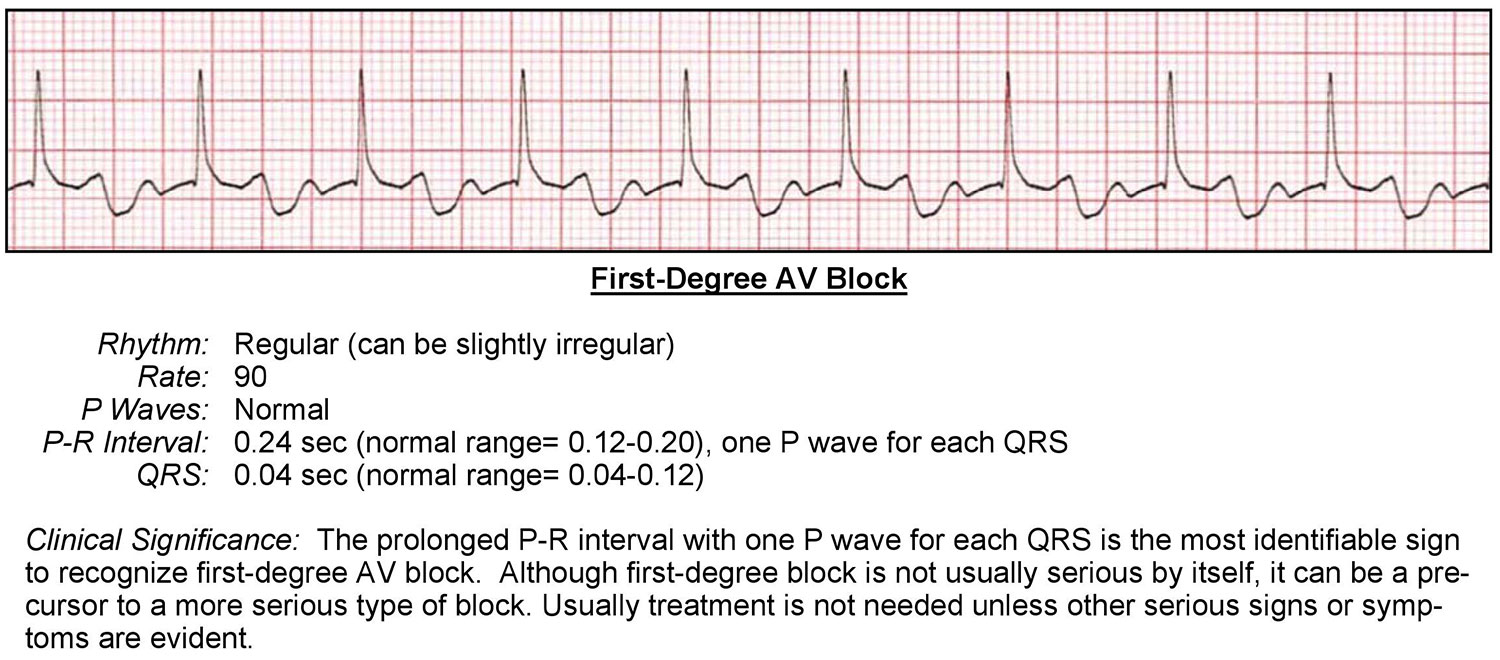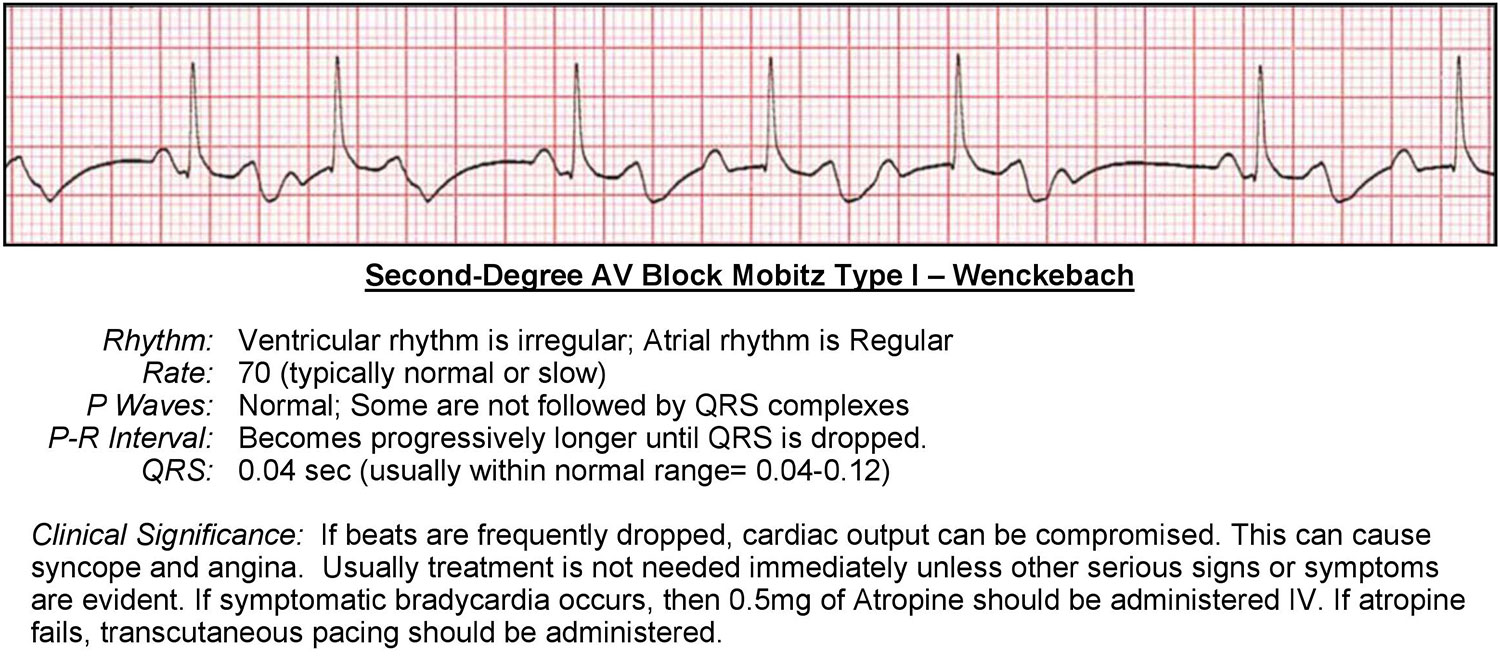Which Best Describes an Av Blocked Rhythm
An ECG rhythm strip shows a regular ventricular rhythm at a rate of 30 beatsmin more P waves than QRS complexes the P waves occur regularly a variable PR interval and a QRS duration of 014 seconds. First-degree AV block is rarely serious and may be left untreated in the majority of cases.

First Degree Atrioventricular Av Block Ecg Review Learn The Heart
To assess CPR quality which should you do.

. With a first-degree AV block this delay in conduction often presents due to a minor defect in. An atrioventricular or AV heart block usually caused by a delay sometimes absent and inconsistent electrical conduction pathway traveling through the AV node. Third-degree AV block c.
Atrioventricular AV heart blocks occur when the electrical transmission from the atria to the ventricles is interrupted either partially or completely. However there is no interruption in the conduction between the atria and the ventricles. Heart blocks are arrhythmias caused by conduction disturbances at the AV node.
Third-degree atrioventricular block What is the recommended range from which a temperature should be selected and maintained constantly to achieve targeted management after cardiac arrest. There is AV dissociation and escape rhythms that may be junctional or ventricular which represent perfusing rhythms. Which best describes this rhythm.
The first-degree heart block takes place where there is an incomplete block. The most common causes of AV block include. Recently the immunosuppressant agent fingolimod used to treat relapsing multiple sclerosis was also found to cause AV block.
Second degree type II. The PR interval of a first-degree AV block____. Analysis of first degree heart block is given below and an example is shown in figure 1-22.
This disruption in normal electrical activity can be transient or permanent and then further characterized as delayed intermittent or absent. Which type of atrioventricular block best describes this rhythm. Atrioventricular AV block is partial or complete interruption of impulse transmission from the atria to the ventricles.
Third-Degree Atrioventricular Block - StatPearls - NCBI Bookshelf. This manifests as a prolonged PR interval on the ECG. Which facility is the most appropriate EMS destination for a patient with sudden cardiac arrest who achieved.
These conditions are referred to as atrioventricular AV blocks which are subdivided according to the degree of block. If no escape rhythm occurs cardiac arrest will ensue. This is due to AV nodal disease or a disease involving the His-Purkinje system caused by coronary artery disease enhanced vagal tone a congenital disorder underlying structural heart disease such as myocardial infarction hypertrophy inflammation or.
The PR interval is 022 s in first-degree AV-block. True TF Heart blocks are partial delays or complete interruptions in the cardiac conduction pathway between the atria and ventricles. Is constant and more than 020 sec in duration.
Which type of atrioventricular AV block best describes this rhythm. First-Degree Incomplete Heart Block. Diagnosis is by electrocardiography.
TF Second degree AV block type I is usually a temporary condition that will resolve itself and return to a normal heart rhythm. These AV blocks are described as a first degree which has a prolonged PR interval beyond 20 seconds the rhythm is regular with a normal or slow rate. Your patient is in cardiac arrest and has been intubated.
First-degree second-degree and third-degree. The QRS complex associated with a third-degree AV block is always wide. Third-degree AV block is a very serious condition because escape rhythms may 1 not occur 2 occur transiently or 3 occur but generate insufficient cardiac output.
First Degree Heart Block. Once every 5 to 6 seconds. A first-degree AV block occurs when electrical conduction through the AV node of the heart is delayed and the impulse between the atria and ventricles is slowed.
To properly ventilate a patient with a perfusing rhythm how often do you squeeze the bag. Mobitz type II is rarely seen in patients without structural heart disease. There are 3 main types of AV heart blocks.
Rhythm is regular with a normal or slow rate. Second-degree AV block type II ANS. True TF The P-P interval is regular with all heart blocks.
32 degrees celsius to 36 degrees celsius. This rhythm is _____. Atrioventricular or AV heart blocks are usually caused by a delayed absent or inconsistent electrical conduction pathway through the AV node.
Second degree atrioventricular AV block type I To properly ventilate a patient with a perfusing rhythm how often do you squeeze the bag. Second-degree heart blocks can be divided into 2 different types but more on that later. Second-degree AV Block Type 2.
The block is located in the atrioventricular node in most cases. Second degree atrioventricular AV block type I. Symptoms and treatment depend on degree of block but treatment when necessary usually involves pacing.
Impulse conduction from the atria to the ventricles may be abnormally delayed or even blocked. This can be due to an anatomical or functional impairment in the hearts conduction system. In 21 AV block the PR interval.
Which best describes this rhythm. First- second- and third-degree AV. 21 AV block b.
Second-degree AV block type I d. An atrioventricular block is a loss of the regular function of the cardiac electroconductive pathways linking the sinoatrial node SA node and the ventricles via conduction through the atrioventricular node AV node. Third-degree AV block may be preceded by second-degree or rarely first-degree AV block.
AV block represents a delay or disturbance in the transmission of an impulse from the atria to the ventricles. Third-degree AV block indicates a complete loss of communication between. An ECG rhythm strip shows a regular ventricular rhythm a t a rate of 30 BPM more P waves than QRS complexes a variable PR interval and a.
All P-waves are followed by QRS complexes. An ECG will show the following. Once every 5 to 6 seconds.
These AV blocks are described as a first degree having a prolonged PR interval beyond 20 seconds. Which type of atrioventricular AV block best describes this rhythm. Atrioventricular AV heart block describes impairment of conduction from the atria to the ventricles via the AV junction.
The most common cause is idiopathic fibrosis and sclerosis of the conduction system. Common drugs that are known to cause AV block include beta-blockers digoxin calcium channel blockers and many antiarrhythmic agents. Extra tissue can thicken scar and damage the pathways that send signals from.
Monitor the patients PETCOS 12-lead. Second-degree AV Block Type 1.

Av Heart Block Poem First Second Third Degree Types Ecg Rhythm Examples Explanation Made Easy Ezmed


No comments for "Which Best Describes an Av Blocked Rhythm"
Post a Comment